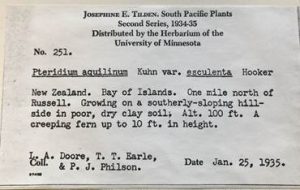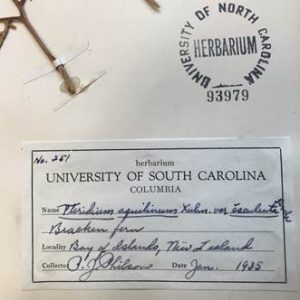(20 August 1905 – 14 February 1998)
The University of North Carolina at Chapel Hill Herbarium (NCU) has cataloged about 50 specimens collected by Paul James Philson, who always signed his specimen labels “P. J. Philson.” All specimens at NCU are vascular plants, and most were collected in New Zealand. As more of our collections are inventoried it is likely more specimens collected by Philson will be found.
Other herbaria curating specimens collected by P. J. Philson include University of Arizona (ARIZ; vascular plants), Brigham Young University (BRY; vascular plants), Campbell University (CAU; vascular plants), Carnegie Museum of Natural History (CM; vascular plants), Field Museum (F; algae), University of Michigan (MICH; algae), Missouri Botanical Garden (MO; vascular plants), New York Botanical Garden (NY; algae), Drexel University (PH; algae), San Diego State University (SDSU; vascular plants), University of California, Berkeley (UC; algae), University of South Florida (USF; algae & vascular plants), University of South Carolina, Columbia (USCH), University of Wisconsin (WIS; vascular plants), and Swedish Museum of Natural History (S; fungi).
Paul James Philson was born on 20 August 1905 in Minneapolis, Minnesota.1 His family must have moved to Greer, South Carolina when he was young as his obituary lists him as a native of that city.2 He earned a B. S. from Furman University (Greenville, South Carolina) in 1928, M.A. from Duke University (Durham, North Carolina) in 1931, and a Ph.D. from the University of Minnesota (St. Paul, Minnesota) in 1935. The title of his thesis was “The freshwater algae of North and South Carolina, Part I. Cyanophyceae,” and his advisor was Dr. Josephine Tilden.3

On 9 October 1934 Philson arrived in Fremantle, Western Australia aboard the “Moldavia” as a member of a botanical expedition to New Zealand and Australia in 1934-1935. His profession, according to the ship documents, was “Phycologist & Taxonomist.”4 Many of the plants collected were distributed in “Josephine E. Tilden. South Pacific Plants, Second Series, 1934-35” exsiccatae. Sometimes Philson incorporated plants collected on the Tilden expedition into his collection, and he usually retained the exsiccatae number as his collection number.
The 1940 census lists P. J. Philson as living in Columbia, Richland County, South Carolina and working as an instructor at the University of South Carolina in that city. His wife, Ruby Austin (1909-1999)5 and three year old daughter, Camilla are listed as living at the same address.1 (A son, Robert Austin Philson was born after 1940.2) Philson served as the Curator of the University of South Carolina Herbarium (USCH) upon the death of Dr. Andrew Charles Moore.6

In 1937 Dr. Philson wrote “Shady ravine on LaConte [sic; LeConte] Farm brings thrills to naturalist,” for the Sunday, May 30th edition of The State newspaper in Columbia, South Carolina:
“To the naturalist no spot is more delightful for a pleasant afternoon of exploring than a cool, damp ravine with its shaded slopes, thick underbrush and usually small creek. Many such spots are located within a short radius of Columbia but none is more delightful than that to be found on the farm of Louis LeConte, 20 miles from Columbia. About 18 miles from Columbia toward Sumter a crossroad connects the Leesburg and Sumter road. The LeConte farm is located on the cross road about two miles from the Sumter highway. Once there and with the permission of Mr. LeConte and possibly a few instructions as to directions the spot in question may easily be located.
The ravine, about a mile from the dwelling, is approximately 300 yards wide and one mile long — an ideal spot for the botanist or for that matter any lover of nature. On the top of each slope sparkleberries, oaks and pines constitute the dominant vegetation. Upon the slopes and floor are hickories, sweet bays, sour wood, and other trees. An interesting feature immediately notices is the great abundance of Rhododendron minus, a laurel not particularly common in this vicinity. These plants, seldom over six feet high, form great clumps which in the spring of the year must make nature herself marvel at her handiwork. The plants are easily identified from the rosebay or great laurel by the absence of any glandular dots or scales on their leaves. The flower is rose colored, though albinos are as common as with most laurels.
It was in the bottom of this ravine that Dr. W. C. Coker discovered a single tree of Magnolia pyramidata or wood-0read.7 Heretofore Georgia was considered as its most northern limit but with this discovery its range must extended into South Carolina. The tree to the untrained eye might well be mistaken for its close relative, the ear-leaf umbrella tree, Magnolia fraseri. The wood-oread is more slender, however, its stamens are much shorter and its opening flowers are more rose bud like. It is about 35 feet high, and five inches in diameter at the base. Other trees of the same kind are probably present in other parts of the state but their discovery is yet to be made.
On the peaty soil froming the floor of the ravine are great masses of royal, cinnamon and Virginia chain ferns as well as delicate little pogonias and green adder’s-mouths, Malaxis uniflora. These two orchids are present in large numbers. The other vegetation is more or less typical of the environment.
Before departing persuade Mr. LeConte to show you some of his prize cultivated shrubbery located about his home. This in itself is worthy of a special trip and one that should be thoroughly enjoyed.”
NCU curates specimens of the Magnolia pyramidata discovered by Dr. William Chambers Coker mentioned in Philson’s article. In 1939 Herbert Hechenbleikner discovered a second tree “about 500 yds. from the one found by W. C. and E. C. Coker”; NCU curates specimens from this tree.
Philson died at age 92 in Georgia, and his obituary says that in addition to working for the University of South Carolina, he worked for the Columbia Waterworks.2 He and his wife Ruby are buried in Westover Memorial Park, Augusta, Richmond County, Georgia.5
PUBLICATIONS (probably a partial list)
Philson, P. J. 1935. The freshwater algae of North and South Carolina, Part I. Cyanophyceae. Ph.D. thesis, University of Minnesota, Dept. of Botany.
Philson, P. J. 1937. Shady ravine on LaConte [sic] Farm brings thrills to naturalist. The State, Columbia, South Carolina. (Sunday morning edition, May 30, 1937).
Philson, P. J. 1939. Freshwater algae of North and South Carolina, Part I., Cyanophyceae. Journal of the Elisha Mitchell Scientific Society 55(1): 83-116.
Philson, P. J. 1940. Species of Oedogonium new to South Carolina. Journal of the Elisha Mitchell Scientific Society 56(1): 106-110.
SOURCES
1. Year: 1940; Census Place: Columbia, Richland, South Carolina; Roll: m-t0627-03833; Page: 18B; Enumeration District: 40-30. Ancestry.com. 1940 United States Federal Census [database on-line]. Provo, UT, USA: Ancestry.com Operations, Inc., 2012. Accessed on 7 February 2019.
- Obituary notice for Paul J. Philson. The Augusta Chronicle (GA) 16 Feb 1998. https://www.ancestryinstitution.com/mediaui-viewer/tree/51676/person/227814286/media/6e19f1f2-d4b0-4594-94ed-2b5e03930fa9 . Accessed on 7 February 2019.
- 63rd Annual Commencement, 1935. University of Minnesota. Page 45. https://conservancy.umn.edu/bitstream/handle/11299/57552/1935-commencement.pdf;jsessionid=F6E0C566EB7D0F65E073D66F6740B7E6?sequence=1 . Accessed on 7 February 2019.
- National Archives of Australia; Queen Victoria Terrace, Parkes ACT 2600.; Inward passenger menifests for ships and aircraft arriving at Fremantle, Perth Airport and Western Australian outports from 1897-1963; Series NumberK K 269; Reel Number: 76. Ancestry.com. Fremantle, Western Australia, Passenger Lists, 1897-1963 [database on-line]. Provo, UT, USA: Ancestry.com Operations, Inc., 2014. https://search.ancestryinstitution.com/cgi-bin/sse.dll?_phsrc=pBo337&_phstart=successSource&usePUBJs=true&qh=6hgPhUxzUOJ5QCJxbNhVzw%3D%3D&gss=angs-g&new=1&rank=1&msT=1&gsfn=paul%20j.&gsfn_x=0&gsln=philson&gsln_x=0&msypn__ftp=Minnesota,%20USA&msypn=26&msbdy=1905&_83004003-n_xcl=f&catbucket=rstp&MSAV=1&uidh=yn9&pcat=ROOT_CATEGORY&h=1258328&recoff=6%207&dbid=5378&indiv=1&ml_rpos=17 accessed on 7 Feb 2019.
- Find A Grave Memorial #23228285.https://www.findagrave.com/memorial/23228285 . Accessed on 7 February 2019.
- Personal communication, John B. Nelson, Curator, USCH via email to McCormick 7 February 2019.
- An “oread” is a mountain nymph. “In Greek mythology, an Oread (/ˈɔːriˌæd, ˈɔːriəd/; Ancient Greek: Ὀρειάς, romanized: Oreiás, stem Ὀρειάδ-, Oreiád-, Latin: Oreas/Oread-, from ὄρος, “mountain”) or Orestiad /ɔːˈrɛstiˌæd, –iəd/; Ὀρεστιάδες, Orestiádes) is a mountain nymph. They differ from each other according to their dwelling: the Idaeae were from Mount Ida, Peliades from Mount Pelion, etc. They were associated with Artemis, since the goddess, when she went out hunting, preferred mountains and rocky precipices.” Wikipedia contributors. “Oread.” Wikipedia, The Free Encyclopedia. Wikipedia, The Free Encyclopedia, 3 May. 2021. Web. 5 Jun. 2021.